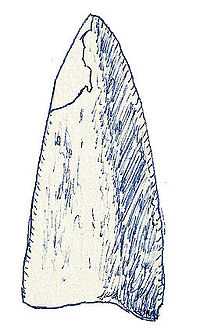Mongolosaurus
| Mongolosaurus Temporal range: Early Cretaceous | |
|---|---|
 | |
| Drawing of tooth | |
| Scientific classification | |
| Kingdom: | Animalia |
| Phylum: | Chordata |
| Class: | Sauropsida |
| Superorder: | Dinosauria |
| Order: | Saurischia |
| Suborder: | Sauropodomorpha |
| Infraorder: | Sauropoda |
| Genus: | Mongolosaurus Gilmore, 1933 |
| Species | |
| |
Mongolosaurus is a genus of sauropod dinosaur which lived during the Early Cretaceous of China.
In 1928 a team from the American Museum of Natural History, headed by Roy Chapman Andrews, at On Gong Gol near Hukongwulong in Inner Mongolia, in Quarry 714 discovered a sauropod tooth. In 1933 Charles W. Gilmore, based on this fossil, named and described the type species Mongolosaurus haplodon. The generic name refers to Mongolia. The specific name is derived from Greek haploos, "single", and odon, "tooth".[1]
The holotype, AMNH 6710, was found in the On Gong Formation of which the stratification is uncertain but which dates from the Lower Cretaceous. It consists of aforesaid tooth. Other remains from the same site have been referred to the species: about half a dozen teeth of the same type, a basioccipital from the back of the skull and parts of the first three cervical vertebrae. The teeth are long and cylindrical. Some other similar teeth from Asia have later been referred.
The relationship of Mongolosaurus to other sauropods is problematic, with some authors listing it as a nomen dubium. It likely belonged to the general Neosauropoda. Having in the past been assigned to the Diplodocidae, Titanosauridae or Euhelopodinae, it is today considered a member of the Nemegtosauridae.
References
- ↑ C.W. Gilmore, 1933, "Two new dinosaurian reptiles from Mongolia with notes on some fragmentary specimens", American Museum Novitates 679: 1-20